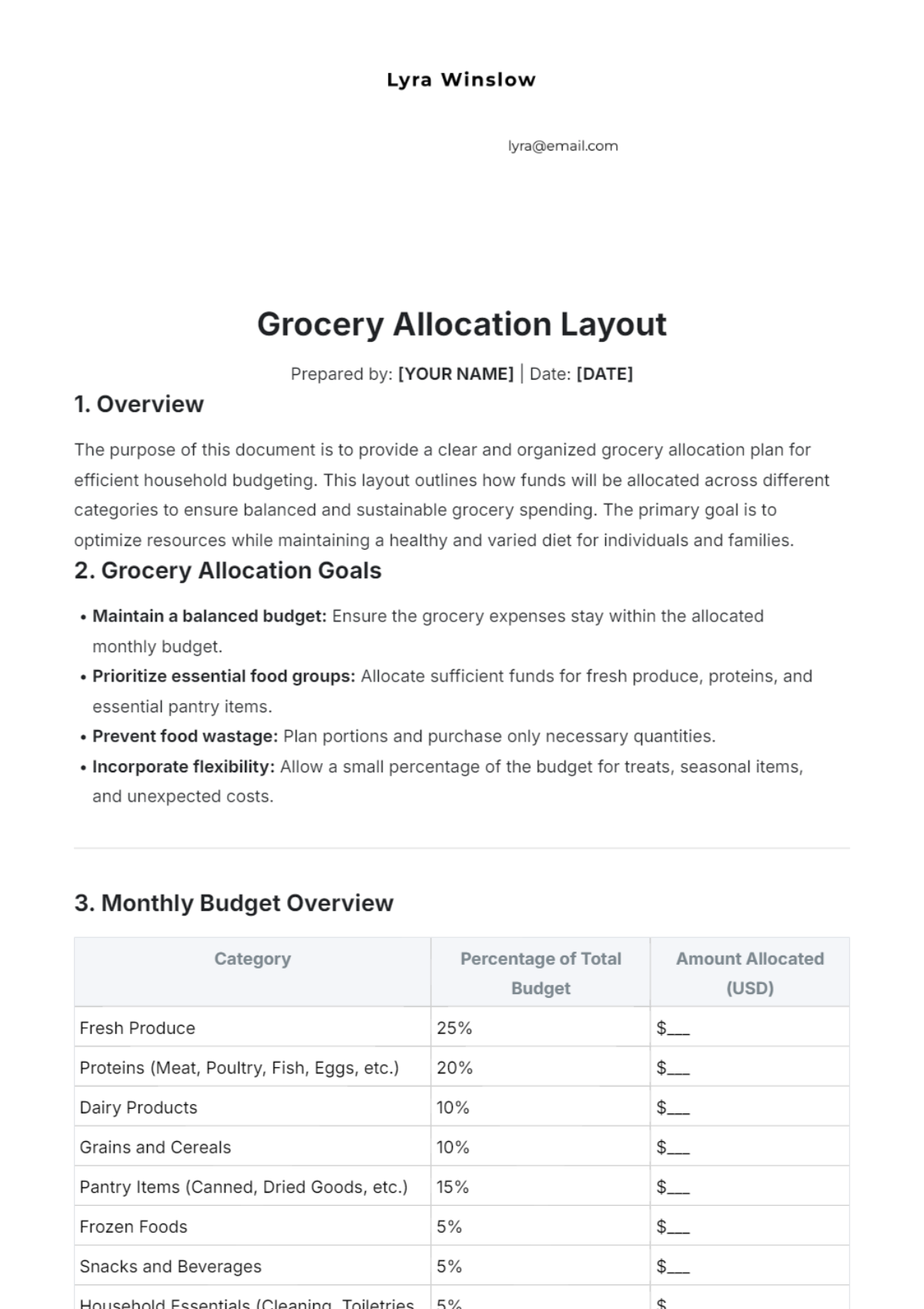Grocery Store Refunds Guideline Format
I. Introduction
A. Purpose of the Guideline
This guideline establishes a standardized process for handling customer refunds to ensure fairness and transparency. It aims to minimize customer dissatisfaction and operational disruptions by providing clear procedures for all refund requests. By adhering to these guidelines, we maintain consistency and uphold our commitment to exceptional customer service.
B. Scope
Coverage of Products
This guideline applies to all grocery items purchased at [Your Company Name], including both dry goods and non-perishable items. Exceptions may apply as detailed in the exclusions section; all online store products are covered.
Applicability to Services
Services such as delivery, installation, or special orders are subject to separate terms and conditions. These services aren't covered by this refund guideline but may have their own policies. Refer to the service agreements or contact support for details.
II. Eligibility Criteria
A. General Conditions for Refunds
Product Condition
To qualify for a refund, products must be returned in their original, unopened packaging, with all tags and labels intact. Used, altered, or damaged items can't be refunded. Products must be resellable and meet health and safety standards.
Timeframe for Refund Requests
Refund requests must be submitted within 30 days of the original purchase date to be considered valid. Requests made after this period won't be processed, except for stated extended return periods. This ensures prompt resolution and addresses issues while the purchase is recent.
B. Exclusions
Perishable Items
Due to their nature, perishable items such as fresh produce, dairy products, and meats are not eligible for refunds. To ensure food safety, defective perishable items should be reported to customer service immediately.
Final Sale Items
Items marked as "Final Sale" at the time of purchase are non-refundable and cannot be returned. This policy manages inventory and pricing for clearance items. Customers should review product details before purchasing final sale items.
Special Orders
Products ordered specifically for a customer or custom-made items are not eligible for refunds. These customized items are non-returnable. For issues, refer to the order confirmation or contact customer service.
III. Refund Request Process
A. In-Store Procedure
Customer Approach
Customers seeking a refund should visit the customer service desk with the product and the original receipt. Upon arrival, they'll be greeted by customer service to promptly assist with the refund request according to store policy.
Refund Request Form
Customers will need to complete a refund request form detailing the purchase and reason for the return. This form streamlines the refund process by providing essential information, which store staff review before initiating the refund.
Verification Process
Store staff will verify the product's condition and receipt to confirm the eligibility for a refund. Verification includes checking the packaging, condition, and matching the receipt with store records. Refunds are processed after verification.
B. Online Procedure (if applicable)
Request Submission
Customers can initiate a refund request through our website by filling out an online refund form. This form needs purchase details, a return reason, the order number, and any relevant attachments.
Required Documentation
Customers must provide a digital copy of the receipt and a photo of the product to complete the refund request. These documents verify the purchase and product condition, reviewed by our customer service for accuracy.
Processing and Confirmation
After submission, customers will receive an email confirmation of their refund request with details on the next steps. Online refunds usually take as long as in-store refunds. Updates and any issues will be emailed.
C. Required Documentation
Receipt
A valid receipt is essential for processing refunds and must be presented either in-store or online. The receipt proves purchase and validates transaction details; refunds require it unless alternative proof is accepted.
Proof of Purchase
If a receipt is not available, other forms of proof of purchase, such as an order number or transaction record, may be accepted. Proof verifiable through our sales system ensures accurate and fair refunds.
Identification Requirements
In cases where the receipt is unavailable, customers may need to provide a valid photo ID to verify their identity. The ID prevents fraud and confirms refund legitimacy; for online purchases, the order number usually suffices.
D. Identification Requirements
Customer ID
For in-store refunds without a receipt, a valid photo ID may be required to process the request. This ID verifies the refund requester’s identity and ensures transaction legitimacy, maintaining the refund process's integrity.
Order Number
For online refunds, customers must provide the order number associated with their purchase. An accurate order number lets customer service quickly locate and verify transaction details, ensuring efficient online refund processing.
Verification Process
The customer’s identification and proof of purchase are cross-checked against store records to confirm the validity of the refund request. This process ensures accurate refunds to the right customer for the correct purchase, resolving any discrepancies beforehand.
IV. Refund Processing
A. Verification of Refund Request
Product Inspection
Returned products will be inspected by store staff to ensure they meet the refund criteria outlined in the policy. This inspection checks packaging, condition, and eligibility. Non-compliant products won't be refunded.
Validity Check
Store records and the refund request details will be verified to confirm the validity of the refund request. We'll match the product and receipt with our sales data and resolve any issues before processing the refund.
Approval Process
Once verified, the refund request is forwarded for final approval. This step ensures criteria compliance and policy adherence. Approval is required before issuing the refund.
B. Timeframe for Processing
Standard Processing Time
Refunds are typically processed within 5-7 business days from the date of the request. This timeframe ensures thorough verification and processing, with customers notified of refund status throughout.
Expedited Requests
For urgent cases, expedited processing may be requested and approved on a case-by-case basis. Expedited refunds need extra verification and store approval. Request them ASAP for a timely resolution.
Notification of Status
Customers will receive updates on their refund request status through email or phone. This communication will include information about the processing stage and any actions required. Ensuring timely updates helps manage customer expectations and satisfaction.
C. Refund Methods
Original Payment Method
Refunds will be issued to the original payment method used at the time of purchase. This method ensures that the refund is processed in a manner consistent with the initial transaction. For credit card payments, refunds will be credited back to the same card.
Store Credit
If the original payment method is unavailable or the customer prefers, store credit may be issued as an alternative. Store credit is flexible, never expires, and benefits frequent shoppers.
Refund Reversal
In cases where the original payment method cannot be used, and store credit is not acceptable, a refund reversal may be considered. This process reverses the transaction through the payment processor, pending approval. Customers will be notified if this option is available.
V. Special Cases
A. Exchanges vs. Refunds
Procedure for Exchanges
Customers may opt for an exchange instead of a refund if they prefer a different product or size. Exchanges must be processed in accordance with the eligibility criteria outlined in this guideline. The new product should be of equal or lesser value to ensure a smooth exchange process.
Conditions for Refunds in Lieu of Exchange
If an exchange is not feasible due to stock limitations or product availability, a refund may be provided instead. Refunds in lieu of exchange will follow the same procedures and criteria as standard refund requests. This ensures that customers are not disadvantaged by limited stock or product unavailability.
Handling Exchange Requests
Employees should handle exchange requests with care and ensure that the customer’s needs are met. This includes assisting with product selection and ensuring that all return and exchange policies are adhered to. Proper handling enhances customer satisfaction and loyalty.
B. Refunds for Damaged or Defective Products
Inspection and Verification
Products reported as damaged or defective will undergo a thorough inspection by store staff to confirm the issue. This inspection determines whether the damage or defect occurred before or after purchase. A defective product will either be replaced or refunded based on the customer’s preference.
Replacement Options
Customers can choose to receive a replacement product if available, rather than a refund. Replacements will be provided subject to product availability and store policies. This option allows customers to receive a product in good condition without processing a full refund.
Resolution for Defective Items
If a product is confirmed defective, the store will take appropriate steps to resolve the issue promptly. This may include issuing a refund, providing a replacement, or offering a discount on future purchases. The resolution process aims to ensure customer satisfaction and maintain product quality.
C. Refunds for Incorrect Purchases
Error Verification
Refunds for incorrect purchases, such as wrong items or quantities, will be processed upon verification of the error. Store staff will check the purchase and verify if a mistake occurred, ensuring accurate and fair refunds.
Resolution Process
Incorrect purchases will be resolved by issuing a refund or correcting the order as preferred by the customer. This may involve exchanging the incorrect item for the correct one to satisfy the customer.
Handling Customer Requests
Employees should assist customers in correcting any purchase errors promptly and courteously. Clear communication and efficient processing maintain customer satisfaction and trust. Unresolved issues should be escalated to a supervisor.
VI. Training and Compliance
A. Staff Training
Training Program
All employees handling refunds will complete a training program on refund procedures and customer service. Regular refresher courses will keep staff updated on any changes in policies.
Training Materials
Employees will receive training materials like manuals and online resources to refer to during their work. These materials help ensure consistent application of refund procedures.
Evaluation and Feedback
Staff performance will be evaluated regularly, and feedback will be provided to improve their handling of refunds. Regular assessments help maintain high standards of service.
B. Compliance Monitoring
Regular Audits
The store will conduct regular audits of refund transactions to ensure compliance with guidelines. These audits help identify and correct any procedural issues.
Incident Reporting
Any issues found during audits will be documented and addressed promptly. This ensures that problems are resolved and procedures are adjusted if needed.
Corrective Actions
Based on audit results, corrective actions will be taken to improve the refund process. These actions may include updating policies or providing additional training.
C. Customer Feedback
Feedback Collection
Customer feedback on the refund process will be gathered through surveys and direct communication. This feedback helps us understand and address customer concerns.
Review and Analysis
All feedback will be reviewed to identify common issues and areas for improvement. This helps refine the refund process to better meet customer needs.
Implementation of Changes
Changes to the refund process will be made based on feedback analysis. Updated procedures will be communicated to both staff and customers.
VII. Customer Communication
A. Communication Channels
In-Store Signage
Refund policies will be displayed clearly in-store to inform customers of the procedures. This helps customers understand how to request refunds.
Online Information
Detailed refund information will be available on the store’s website for online shoppers. This provides customers with easy access to refund procedures.
Customer Service Support
Customer service representatives will be available to assist with refund inquiries. Effective communication ensures that customers receive the help they need.
B. Informing Customers of Policy Changes
Announcement Procedures
Changes to the refund policy will be communicated through in-store signage and website updates. This ensures that customers are aware of any new procedures.
Transition Periods
A transition period may be provided to help customers and staff adjust to new policies. This helps minimize disruptions during policy changes.
Feedback Mechanism
Customers will be encouraged to provide feedback on policy changes. This feedback will be used to assess the impact of the changes and make further adjustments if needed.
C. Handling Difficult Situations
Escalation Procedures
Difficult refund situations will be escalated to a supervisor or manager. This ensures that complex issues are handled appropriately.
Resolution Strategies
Effective strategies will be used to resolve customer complaints related to refunds. This may include offering alternatives or additional support.
Documentation and Follow-Up
All difficult cases will be documented and followed up to ensure resolution. Proper documentation helps track issues and ensures they are addressed.
VIII. Legal and Regulatory Compliance
A. Compliance with Local Regulations
Understanding Local Laws
Refund policies will comply with all relevant local, state, and federal regulations. This helps avoid legal issues and ensures fair treatment.
Regular Reviews
The policy will be reviewed regularly to stay up-to-date with changing regulations. This keeps the policy compliant and effective.
Training on Compliance
Staff will be trained on legal requirements related to refunds. This ensures adherence to laws and proper handling of refund requests.
B. Documentation and Record Keeping
Transaction Records
Detailed records of refund transactions will be kept for accuracy and compliance. These records support transparency and accountability.
Retention Periods
Refund records will be retained for the required period as per regulations. This ensures that records are available for audits and legal reviews.
Access and Security
Access to refund records will be restricted to authorized personnel. This protects sensitive information and maintains data security.
C. Handling Disputes and Legal Issues
Dispute Resolution
Disputes related to refunds will be resolved through established procedures. This may include mediation or arbitration if necessary.
Legal Counsel
Legal advice will be sought for unresolved disputes or legal challenges. This ensures proper handling of complex legal issues.
Customer Communication
Clear communication will be maintained with customers during legal disputes. This helps manage expectations and preserve trust.
IX. Special Considerations
A. Refunds for Promotional Items
Policy Application
Refunds for promotional items will follow the terms of the promotion. This ensures that refunds are processed according to the promotion’s rules.
Adjustments for Discounts
Refunds will reflect the promotional discount applied to the purchase. This ensures accurate refund amounts.
Promotional Refund Limitations
Some promotions may have restrictions on refunds, which will be communicated to customers. Understanding these limitations helps manage expectations.
B. Refunds for Gift Cards
Gift Card Refunds
Purchases made with gift cards will typically not be refunded, but any refunds will be credited back to a new gift card or store credit. This ensures proper handling of gift card funds.
Gift Card Balance Checks
The balance on the gift card will be checked before processing a refund. This ensures that the refund amount is accurate.
Policy Communication
The policy for gift card refunds will be clearly communicated to customers. This helps avoid confusion about how gift card refunds are handled.
C. Refunds for Online Orders
Online Return Procedures
Refunds for online orders will follow specific return instructions provided on the store’s website. This streamlines the return and refund process.
Shipping and Handling Costs
Refunds for online orders usually do not include shipping and handling costs unless the store made an error. Customers will be informed about any deductions.
Processing Time
The processing time for online order refunds will be communicated to customers. This helps manage expectations for receiving their refunds.
X. Exceptions and Special Cases
A. Non-Refundable Items
Defined Categories
Some items may be non-refundable, such as perishable or personalized items. These will be clearly defined in store policies.
Customer Notification
Customers will be informed if an item is non-refundable at the time of purchase. This prevents misunderstandings and ensures clarity.
Handling Non-Refundables
Non-refundable items returned will be handled according to store policies, and alternative solutions may be offered. This helps manage customer expectations.
B. Refunds for Unauthorized Transactions
Investigation Process
Unauthorized transactions will be investigated thoroughly to verify the claim. This ensures accurate handling of refunds related to fraud or errors.
Verification and Resolution
Verified unauthorized transactions will be refunded or adjusted as necessary. This resolves issues promptly and fairly.
Fraud Prevention
Measures will be in place to detect and prevent fraudulent transactions. This protects both the store and customers from fraud.
C. Refunds for Returns Past the Policy Period
Policy Flexibility
Returns past the refund period may be considered on a case-by-case basis with management approval. This provides flexibility while maintaining policy integrity.
Documentation Requirements
Customers will need to provide documentation for late returns. This helps verify the return and ensure proper handling.
Customer Communication
Customers will be informed about the outcome of their late return requests and offered alternatives if needed. This maintains transparency and customer satisfaction.
XI. Review and Updates
A. Regular Policy Review
Scheduled Reviews
The refund policy will be reviewed annually to ensure it remains effective. Regular reviews help keep the policy up-to-date.
Feedback Integration
Feedback from customers and staff will be used to improve the policy. This helps address issues and enhance the refund process.
Implementation of Changes
Any policy changes will be implemented and communicated to staff and customers. This ensures that everyone is informed and updated.
B. Policy Updates and Communication
Documentation of Changes
All updates to the refund policy will be documented and recorded. This provides a clear record of changes made.
Notification Procedures
Significant policy changes will be communicated through signage and online updates. This keeps everyone informed about new procedures.
Ongoing Monitoring
The impact of policy changes will be monitored to ensure effectiveness. This helps assess whether changes meet their intended goals.
























